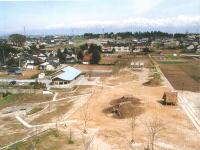| The Jomon Village in Toyama Kitadai National Historic Site |
 |
| The Jomon Village in Toyama Kitadai National Historic Site |
 |
| The Kitadai site is of Jomon village(around
2000 BC),where the ruins of more than 70
pit dwellings and raised floor buildings,a
large amount of Jomon pottery and stone tools
were uncovered.It was designated as a National
Historic Site in 1984.With support of the
Agency for Cultural Affairs,the Jomon village
was restored and opened to the public in
1999. This village was located at the foot of Kureha hill and favored with clear water from a nearby spring.Several family groups lived with in the village.Each of them had some pit dwellings and a warehouse with the floor raised above the ground at the center.The floor of the pit dwellings was 60cm under the ground and a sunken hearth was constructed.Five to seven chestnut tree posts were planted upright to support the roof,which was thatched with the bark and branches of the chestnuts tree as the base and covered with humus.Because of its structure,the temperature inside the house was comfortable throughout the year.The floor of the warehouse was 1.7 meters high above the ground and six posts supported them.The warehouse was used to store provisions such as nuts and meat. Excavation of this site has yielded a lot of typical Jomon artifacts,including Jomon pottery,Dogu,enigmatic(triangular) clay objects and various kinds of stone tools.Jomon pottery is earthenware fired at 800-900℃.The pottery found at this site is characterized by the surface decoration made with shell imprints.Dogu is a clay figurine modeled after pregnant women.It is thought that stones were inlaid as the eyes because the asphalt used as glue remains.A number of stone tools have been unearthed on this site.These include axes used for cutting down trees,mortars and grinding stone for grinding nuts,hoes for digging and arrowheads.Jade,precious stone for marking accessories,was also discovered. |